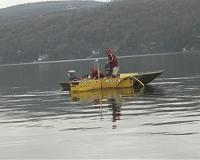| . |  |
. |
Alumot, Israel (AFP) May 3, 2010 The once mighty Jordan River, where Christians believe Jesus was baptised, is now little more than a polluted stream that could die next year unless the decay is halted, environmentalists said on Monday. The famed river "has been reduced to a trickle south of the Sea of Galilee, devastated by overexploitation, pollution and lack of regional management," Friends of the Earth, Middle East (FoEME) said in a report. More than 98 percent of the river's flow has been diverted by Israel, Syria and Jordan over the years. "The remaining flow consists primarily of sewage, fish pond water, agricultural run-off and saline water," the environmentalists from Israel, Jordan and the West Bank said in the report to be presented in Amman on Monday. "Without concrete action, the LJR (lower Jordan River) is expected to run dry at the end of 2011." The river -- which runs 217 kilometres (135 miles) from the Sea of Galilee to the Dead Sea -- and its tributaries are shared by Israel, Jordan, Syria and the West Bank. In 1847, a US naval officer who led an expedition along the river described navigating down cascading rapids and waterfalls. Today the Jordan is a brackish stream barely a few metres (yards) wide. A couple of kilometres south of the Sea of Galilee -- which is actually a lake -- a dam cuts off the flow of the river. Just south of the dam, raw sewage gushes from a pipe. "This is what is today the source of the lower Jordan River," FoEME director for Israel Gidon Bromberg says, pointing to the foul-smelling water. "No one can say this is holy water. No one can say this is an acceptable state for a river this famous worldwide." A few metres away, saline water -- diverted from salt springs to protect the nearby lake -- flows into the foaming brown mess. About 100 kilometres downstream, a Russian clad in a white robe immerses himself in the river at a site in Jordan where many Christians believe Jesus was baptised. Every year, thousands of pilgrims take the plunge in the biblical river despite alarmingly high pollution. Israeli, Jordanian and Palestinian communities along the lower Jordan river -- about 340,000 people in all -- dump raw sewage into the river. Ironically, if the sewage stops flowing into the river -- which Israel plans to do on its stretch -- the damage could be even greater unless additional measures are taken to reduce the salinity of the water. FoEME believes the solution lies in releasing huge amounts of fresh water into the river. The Jordan once had a flow of 1.3 billion cubic metres (45.5 billion cubic feet) a year, but now discharges only an estimated 20 million to 30 million cubic metres into the Dead Sea. "A new study we commissioned reveals that we have lost at least 50 percent of biodiversity in and around the river due to the near total diversion of fresh water, and that some 400 million cubic metres of water annually are urgently needed to be returned to the river to bring it back to life," said Munqeth Mehyar, FoEME's Jordanian director. Israel, Syria, Jordan must all return water to the ailing river, the report says. Israel, having diverted the largest share and being a developed nation, should return a proportionally higher percentage of water, it adds. Better management could save Israel 517 million cubic metres of water a year and Jordan 305 million cubic metres, part of which could be allocated to the Jordan river, the environmental group says. Improving the flow of the Jordan River would also go a long way towards saving the Dead Sea, which is in turn withering rapidly.
Share This Article With Planet Earth
Related Links Water News - Science, Technology and Politics
 Low Oxygen Resources In Central New York's Three Rivers System
Low Oxygen Resources In Central New York's Three Rivers SystemSyracuse NY (SPX) Apr 30, 2010 A unique three-year longitudinal and vertical study of Central New York's Three Rivers system-involving the Oswego, Oneida and Seneca rivers-has revealed that oxygen resources have become degraded by several stressors, including the impact of wastewater treatment plants, nonpoint runoff, an increase in invasive zebra mussels and channelization of the flow. As oxygen is necessary to support ... read more |
|
| The content herein, unless otherwise known to be public domain, are Copyright 1995-2010 - SpaceDaily. AFP and UPI Wire Stories are copyright Agence France-Presse and United Press International. ESA Portal Reports are copyright European Space Agency. All NASA sourced material is public domain. Additional copyrights may apply in whole or part to other bona fide parties. Advertising does not imply endorsement,agreement or approval of any opinions, statements or information provided by SpaceDaily on any Web page published or hosted by SpaceDaily. Privacy Statement |